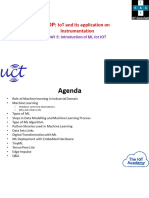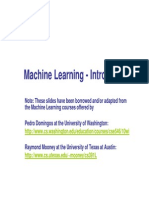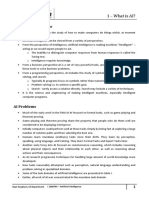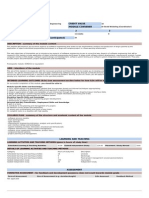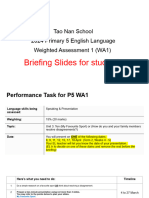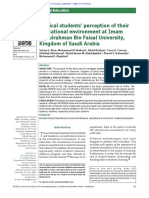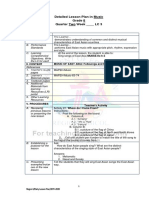0% found this document useful (0 votes)
261 views52 pagesIntroduction To AI and ML 50 Slides Presentation
The document is a comprehensive educational presentation on Artificial Intelligence (AI) and Machine Learning (ML), covering definitions, history, types, applications, and key concepts. It discusses various learning methods, model evaluation metrics, and the ethical implications of AI. Additionally, it outlines the AI model lifecycle, trends, challenges, and career opportunities in the field.
Uploaded by
panil jainCopyright
© © All Rights Reserved
We take content rights seriously. If you suspect this is your content, claim it here.
Available Formats
Download as PPTX, PDF, TXT or read online on Scribd
0% found this document useful (0 votes)
261 views52 pagesIntroduction To AI and ML 50 Slides Presentation
The document is a comprehensive educational presentation on Artificial Intelligence (AI) and Machine Learning (ML), covering definitions, history, types, applications, and key concepts. It discusses various learning methods, model evaluation metrics, and the ethical implications of AI. Additionally, it outlines the AI model lifecycle, trends, challenges, and career opportunities in the field.
Uploaded by
panil jainCopyright
© © All Rights Reserved
We take content rights seriously. If you suspect this is your content, claim it here.
Available Formats
Download as PPTX, PDF, TXT or read online on Scribd
/ 52
Introduction to Artificial
Intelligence and Machine
Learning
Comprehensive 50-Slide Educational
Presentation
What is Artificial Intelligence (AI)?
• AI is the simulation of human intelligence
processes by machines, especially computer
systems.
History of AI
• AI has evolved since the 1950s through
symbolic AI, expert systems, and now machine
learning and deep learning.
Types of AI
• 1. Narrow AI
• 2. General AI
• 3. Super AI
What is Machine Learning (ML)?
• ML is a subset of AI that allows systems to
learn and improve from experience without
being explicitly programmed.
Difference Between AI and ML
• AI is the broader concept; ML is a specific
application of AI based on learning from data.
Supervised Learning
• Model learns from labeled data. Examples:
classification and regression.
Unsupervised Learning
• Model works on unlabeled data. Examples:
clustering and dimensionality reduction.
Reinforcement Learning
• Model learns by interacting with the
environment and receiving rewards or
penalties.
Applications of AI
• Healthcare, finance, manufacturing, customer
service, and more.
Applications of ML
• Email filtering, recommendation engines,
fraud detection, self-driving cars.
Key Concepts in ML
• Features, labels, training/testing sets,
overfitting, underfitting.
AI in Daily Life
• Voice assistants, chatbots, image recognition,
translation tools.
Data Preprocessing
• Cleaning, transforming, and preparing data
before training ML models.
Training vs Testing
• Training: fitting the model to data. Testing:
evaluating model performance.
Common Algorithms
• Linear Regression, Decision Trees, KNN, Naive
Bayes, SVM.
Deep Learning
• Subset of ML using neural networks with many
layers to learn complex patterns.
Neural Networks
• Inspired by the human brain, consists of input,
hidden, and output layers.
Activation Functions
• Functions like ReLU, Sigmoid used to introduce
non-linearity in neural networks.
Natural Language Processing (NLP)
• AI applied to language understanding,
generation, and translation.
Computer Vision
• AI techniques to understand images and
videos.
Model Evaluation Metrics
• Accuracy, precision, recall, F1-score, ROC-AUC.
Cross-Validation
• Technique to assess how the results of a
model will generalize to an independent
dataset.
Bias and Variance
• Trade-off in ML models; balance needed for
good generalization.
Overfitting and Underfitting
• Overfitting: model too complex. Underfitting:
model too simple.
Gradient Descent
• Optimization algorithm used to minimize loss
function in ML.
Loss Functions
• Functions that measure the difference
between actual and predicted values.
Feature Engineering
• Creating new input features to improve model
performance.
Hyperparameter Tuning
• Process of adjusting parameters to improve
model performance.
Model Deployment
• Process of making ML model available for real-
time use.
Ethics in AI
• Issues like bias, fairness, transparency, and
accountability in AI.
Explainable AI (XAI)
• Techniques to interpret and explain ML
models' decisions.
AI in Healthcare
• Disease prediction, drug discovery, medical
imaging analysis.
AI in Finance
• Algorithmic trading, credit scoring, fraud
detection.
AI in Education
• Personalized learning, automated grading,
tutoring systems.
AI in Autonomous Vehicles
• Self-driving cars use ML for object detection
and decision-making.
AI in Robotics
• Robots using AI for navigation, manipulation,
and interaction.
AI in Cybersecurity
• Threat detection, anomaly detection,
automated response.
Big Data and AI
• AI systems leverage massive datasets for
better accuracy and insights.
Cloud and AI
• AI models deployed on cloud for scalability
and access.
AI Tools and Platforms
• TensorFlow, PyTorch, Scikit-learn, Keras.
AI Model Lifecycle
• Define problem > Collect data > Train model >
Evaluate > Deploy > Monitor.
Data Science vs ML vs AI
• AI: Broad field. ML: Subset. Data Science:
Data-focused, uses ML.
AI Trends
• Edge AI, federated learning, AI chips, self-
supervised learning.
Challenges in AI
• Data privacy, lack of explainability, algorithmic
bias.
Future of AI
• More human-like reasoning, general
intelligence, ethical use of AI.
Building an ML Model: Step-by-
Step
• Define problem > Acquire data > Prepare data
> Train > Evaluate > Deploy.
Real-World Case Study
• Example of AI used in COVID-19 diagnosis or
Netflix recommendations.
How to Learn AI/ML
• Courses, hands-on projects, certifications,
open-source contributions.
AI and ML Careers
• Data Scientist, ML Engineer, AI Researcher,
NLP Engineer.
Summary and Key Takeaways
• Reviewed key AI/ML concepts, applications,
and challenges.
Q&A
• Open discussion and clarifications on AI and
ML topics.

